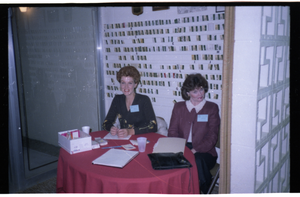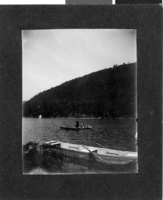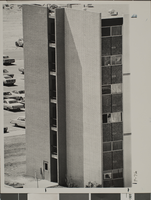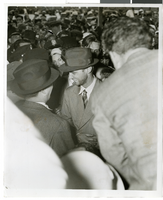Search the Special Collections and Archives Portal
Search Results
Location scouting for The Sin of Harold Diddlebock, New York, New York, production stills: photographic prints and negatives, 1946
Level of Description
File
Archival Collection
Howard Hughes Film Production Records
To request this item in person:
Collection Number: MS-01036
Collection Name: Howard Hughes Film Production Records
Box/Folder: Box 314 (Restrictions apply)
Collection Name: Howard Hughes Film Production Records
Box/Folder: Box 314 (Restrictions apply)
Archival Component

Film transparency of Chris Hall and an unidentified woman at an event at the Mesquite Club of Las Vegas, Nevada, mid-1980s
Date
1983 to 1986
Description
L-R: an unidentified woman and Chris Hall at a registration table at an unknown event at the Mesquite Club of Las Vegas, Nevada.
Image

Photograph of Rockwell family members on the Chemung River, New York, 1902
Date
1902
Archival Collection
Description
Rockwell family members in a boat on the Chemung River near Elmira, New York. Handwritten on back of photograph: "1902 vacation on Chemung River, NY."
Image

Photograph of Tonopah Hall Dorm, Las Vegas, circa 1960s-1970s
Date
1960 to 1979
Archival Collection
Description
An exterior view of Tonopah Hall (dormitory) at the University of Nevada, Las Vegas (UNLV).
Image
Cowboy at the Pioneer Hotel and Gambling Hall, 1986
Level of Description
File
Archival Collection
Neon in Nevada Photograph Collection
To request this item in person:
Collection Number: PH-00225
Collection Name: Neon in Nevada Photograph Collection
Box/Folder: Binder PB-005
Collection Name: Neon in Nevada Photograph Collection
Box/Folder: Binder PB-005
Archival Component
University of Nevada, Reno Peavine Hall, 2015
Level of Description
File
Archival Collection
American Institute of Architects (AIA) Nevada Design & Service Awards Records
To request this item in person:
Collection Number: MS-00897
Collection Name: American Institute of Architects (AIA) Nevada Design & Service Awards Records
Box/Folder: Digital File 00
Collection Name: American Institute of Architects (AIA) Nevada Design & Service Awards Records
Box/Folder: Digital File 00
Archival Component

Photograph of Howard Hughes at Floyd Bennett Airfield, New York, July 14, 1938
Date
1938-07-14
Archival Collection
Description
The up close view of Howard Hughes being escorted through a crowd of people at Floyd Bennett Airfield in New York. Description printed on photograph's accompanying sheet of paper: "Escorted through crowd- 7/14/38 (Daily News)"
Image

Photograph of Howard Hughes at Floyd Bennett Airfield, New York, July 14, 1938
Date
1938-07-14
Archival Collection
Description
The up close view of Howard Hughes being escorted through a crowd of people at Floyd Bennett Airfield in New York. Description printed on photograph's accompanying sheet of paper: "Escorted through crowd- 7/14/38 (Daily News)"
Image

Photograph of Howard Hughes at Floyd Bennett Airfield, New York, July 14, 1938
Date
1938-07-14
Archival Collection
Description
The up close view of Howard Hughes being escorted through a crowd of people at Floyd Bennett Airfield in New York. Description printed on photograph's accompanying sheet of paper: "Escorted through crowd- 7/14/38 (Daily News)"
Image

Photograph of Howard Hughes at Floyd Bennett Airfield, New York, July 14, 1938
Date
1938-07-14
Archival Collection
Description
The up close view of Howard Hughes being escorted through a crowd of people at Floyd Bennett Airfield in New York. Description printed on photograph's accompanying sheet of paper: "Escorted through crowd- 7/14/38 (Daily News)"
Image
Pagination
Refine my results
Content Type
Creator or Contributor
Subject
Archival Collection
Digital Project
Resource Type
Year
Material Type
Place
Language
Records Classification
